|
11.1.1 - Coil Spring Replacement ( Dan Davis,
September 21, 2005
)
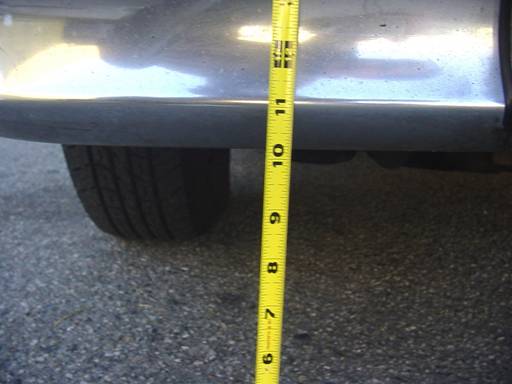
Original ride height
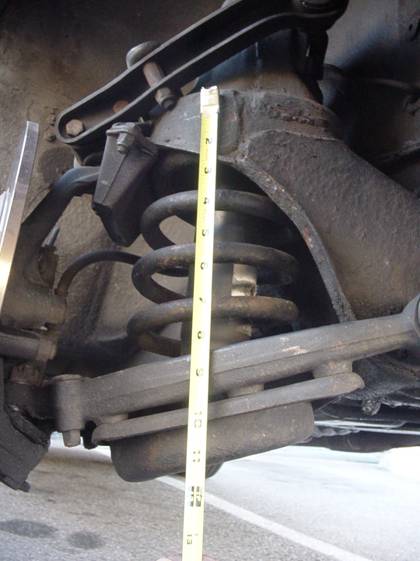
Measuring the starting length of the spring
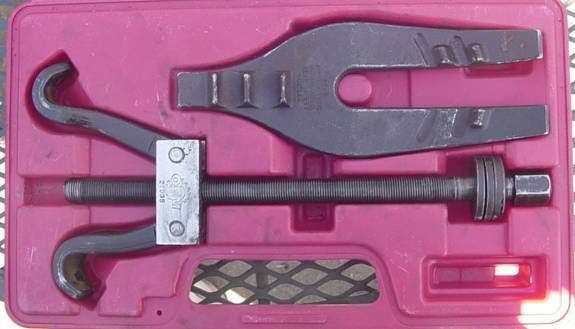
Spring Compressor rented from AutoZone
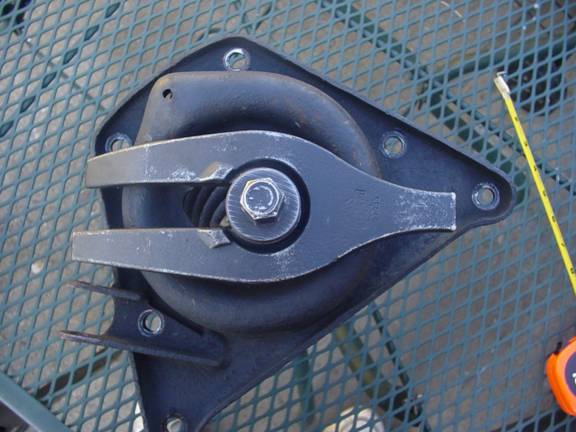
Spring Compressor installed, bottom view
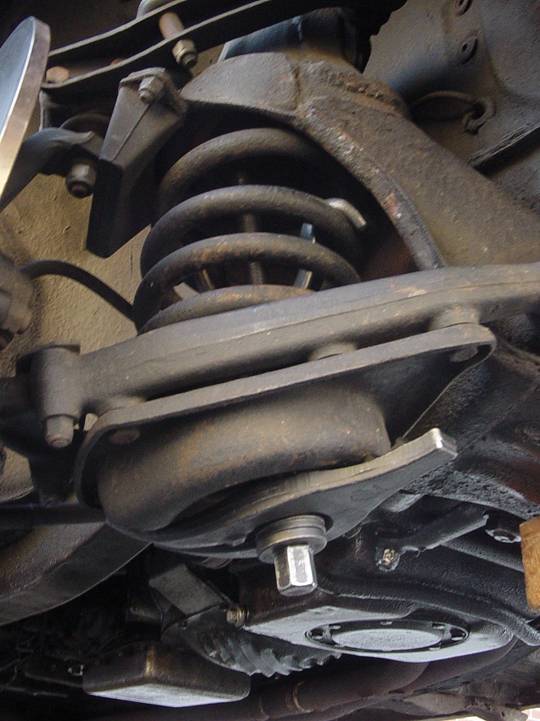
Spring Compressor installed, side view

Spring Compressor installed, spring removed
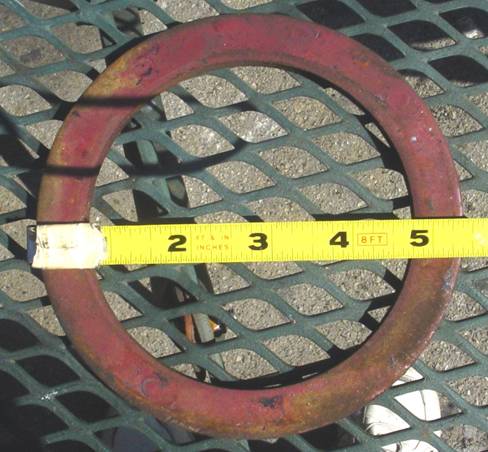
Original packing piece for the spring
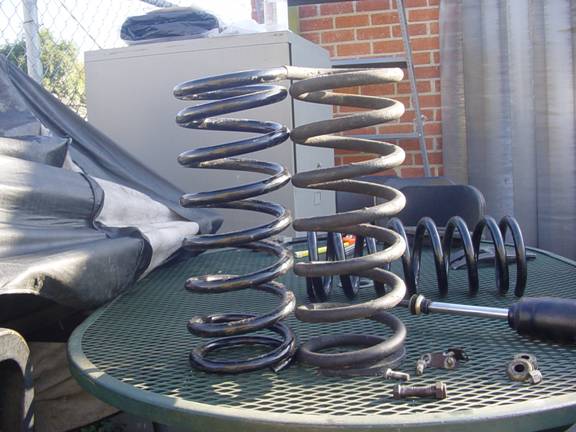
New and old spring side by side.
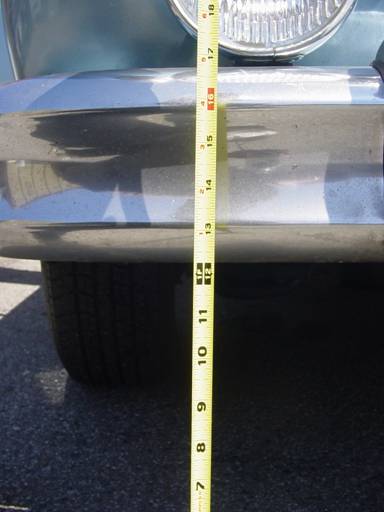
Finished ride height. Two inches higher after installing the new springs!
|
Changing the Coil springs in a Jaguar Saloon
By Dan Davis 1959 3.4 Litre RHD Automatic
Legal Disclaimer:
The Haynes manual starts the section on removal and refitting of coil springs as follows:
“WARNING: These are extremely heavy springs of about 14” free length. We strongly recommend that you do not attempt remove them unless you are fully competent to do so and have all the necessary equipment. Any attempt to remove, or replace, these springs using unsuitable equipment could result in a serious accident.”
Now that’s an understatement if I ever heard one. The information which follows is my own account of how I managed to survive the procedure. You may not be as fortunate.
When I purchased my car, it was fairly evident that it sat to low in the rear. So, one of the first things that I had done, was to pick up a set of replacement leaf springs and have my mechanic replace them.
Before I sent it off for the repair, I crawled underneath to get a look, and found that there were cracked leaves on both sides. This obviously needed to get done!
When I got the car back, I was very disappointed to see that the front of the car now seemed to droop. And to make matters worse, the new leaf springs creaked like the dickens.
This turned out to be just one of the repairs that my mechanic charged me 50% more than the quote for, and I ended up redoing myself at a later date. But that's a separate story.
The coil springs scared my a little. Years ago I had a Ford Capri, and due to financial circumstances, was forced to replace the McPherson struts myself.
The struts were surrounded by coil springs which had to be compressed before I could remove them from the car.
Not having the right tools for the job was always my specialty, so I improvised. I grabbed a bunch of coat hangers, cut about 40 four inch pieces, and began the process of wrapping them around a pair of coils at a time, cinching them together by twisting the loose ends with a pair of vise grips. It was tedious and slow, but eventually, I got the springs down to a point where they could be removed, and carefully set to the side while I removed the struts.
It was shortly thereafter, that my roommate came home with the groceries. With the bags in her arms, she could see that I was under the car, but didn't notice the coil springs sitting against the side of the house. Naturally, she kicked them. I didn't see it myself, but a neighbor later told me that the springs reached an altitude of about a hundred feet, and just missed taking my roommates head off by inches!
The coil springs in a Jaguar saloon are much stronger than the coils in a Capri, and it was with this in mind that I spent a year or so reading up on the procedure, and browsing through the archives to see how others had tackled the problem.
I advise this process over all others. The manual is poorly written, your mechanic does not know what he's talking about, but the experience of others on this list is invaluable when determining the correct and incorrect way to go about things.
In general, most every listing was in agreement. The proper Churchill tool is worth more than the car, and can not be found.
Some had tried garden variety spring compressors and found that they fouled inside the shock tower, and made the job difficult if not impossible. The general consensus of opinion was to locate several lengths of 3/8" x 24 grade 5 threaded rod stock, cut these into either three or four lengths of 10" - 12" and carefully remove a bolt from the spring plate and replace it with the threaded rod backed up by a couple of washers and double nuts for safety. The group which called for three rods, also preferred adding a single 5/8" rod through the center of the spring to carry the bulk of the load. Others seemed to feel that four of the 3/8" were sufficient, although warnings were given in both cases. Either way, this procedure meant backing off on the nuts in turn, to relieve the pressure on the spring plate, until the springs were loose and the spring plate could be removed. This sounded good to me, so I crawled back under my car to try and visualize the process before I gathered up the materials. What I found was not good news. The bolts which hold the spring plate to the lower wishbone sit in a 1/2" recess inside the spring plate. I tried to put an open end spanner on one of them, and found that I could only turn the bolt about a flat at a time due to the recess. I pictured myself under the car for a few days at this point, carefully backing the nuts down the rods a flat a time. It was time to go back to the archives. One post offered some hope, a lister had found a specialized ratchet tool at Sears which had a socket with a hole in it, allowing it to go over rod stock. This was just the ticket! Off to Sears where I located the unusual ratchet. But it could only be purchased as part of a set at $50. I gave this some thought, and determined that I would probably never use this tool again, and I did not want to spend more on parts and tools than it would have cost me to hire a mechanic to do the job.
The next day, I mentioned my troubles to a co-worker. He told me that his son had recently rented a spring compressor from Auto Zone, and replaced the front springs in his pickup truck. I told him that Jaguars were a bit different than pickup trucks, and these tools would probably be more trouble than they were worth. But just to be thorough I went down to Auto Zone to see what they had. I asked the counter guy if they had a good single rod spring compressor, and he said they did, and disappeared into the back to get it. When he showed it to me, I could not think of a good reason why I shouldn't give it a try, since I could rent it indefinitely, and they would refund 100% of the rental cost when I returned it. With a plan "B" in place, it was time to get started.
Back under the car, I went through the process of visualizing each process. The spring compressor began to look better and better as it only needed to pull the spring down a few inches against the pan, and at that point the entire assembly could be removed.
Step 1 - Measure the before height
Both sides measured the same, 11 1/8" to the crease in the bumper.
Step 2 - Measure the starting length of the spring
I would need this measurement to determine how high I would need to get the front end in order to remove the spring from the bottom. With the wheel off the ground, the spring measured about 11". The new springs were just more than 14", so I would need to plan on being able to compress the new springs at least 3" to get them back in the tower. Notice in this picture, the differences in angle between the spring pan and the coil. Some wrestling will be needed down the line to get this all to go back together!
Step 3 - Get it up!
I blocked the rear wheels, and with a rolling jack in the center of the front cross member lifted both front wheels off the ground and supported the car with two jack stands for good measure. Pulled both front wheels, and removed the shock absorber from the left side.
Step 4 - Double check, and prepare
I measured the distance below the spring plate at 10", this I reasoned was enough to get the spring out. I then loosened each of the bolts a quarter turn and retightened to be sure I wouldn't be fighting with a seized bolt later in the process.
Step 5 - The big squeeze
Here is the coil compressor I rented. It is marked OEM 27035.
After applying some motor oil to the threads, I extended the claws to the end of the rod, and passed it up through the spring plate where I set the claws on the highest sections of coil that I felt didn't interfere with the tower. I then attached the forked plate over the bolt, below the spring pan, and adjusted its position so that I would have access to all 6 mounting bolts.
After 135 quarter turns of the ratchet wrench, the spring popped out of its seat at the top, and I knew it was loose.
Here, I sat back and gave it a good look. Somewhere in the distance I could hear a small voice saying "Tell me again how you lost your arm, Grandpa!"
This reminded me that I wanted to be real sure that I wasn't doing something very stupid before I removed the mounting bolts from the spring plate!
After I had convinced myself that it all made sense, I began removing the bolts, checking along the way for more tension than I would expect.
No worries! The spring, compressor and spring plate came out the bottom just as planned. Over on a table I set the assembly on it's side, and decompressed the spring to it’s full length, where I could remove the compressor and spring.
The other piece which fell out was the original packing piece that Jaguar introduced with the advent of the 3.4 Litre to give an extra bit of oomph to support the heavier engine.
As you can almost see from my award winning photograph, this piece is ¼” thick, and measures somewhere around 5-3/8” in diameter.
Now for the first moment of truth. I sat the old spring next to the new spring to try and determine how much more lift I could expect for my trouble.
Bugger! They are both virtually identical. If anything, the old spring is 1/16th taller than the new spring. This certainly puts a damper on my enthusiasm, but I resolve to carry on, just in case forces are at work which I do not understand :)
Step 6 – Installation is the reverse of this procedure.
The new spring sits in the spring pan with the flat side up.
The bottom of the spring is not flat, and the lower portion of the coil fits into the trough in the pan so that the end of the spring fits in the lowest part of the trough. I laid some pieces of duct tape into the trough before I fitted the spring in a foolhardy attempt to reduce spring noise down the road. I then taped the packing piece to the top of the spring so I would not have to worry about it falling off at an inopportune moment.
On goes the ratchet wrench, and 135 quarter turns later, the new spring is small enough to stuff back into the tower. You may recall earlier that I mentioned that the spring pan was not perpendicular to the tower. This is where that information comes in to play. In order to properly seat the spring and get the bolts in, I first screwed in the one bolt which could reach its threads. Then with a bottle jack, I raised the opposite corner in order that I could get the next bolt in place.
Now that all of the bolts and their respective holes are aligned, they were all tightened down, and the shock absorber was replaced.
This entire process took 2 hours. Broken down, that was 1 hour to do the actual work, and 1 hour spent contemplating my mortality.
The other side was completed 45 minutes later.
The second moment of truth
On go the wheels, down goes the jack, once around the block to settle the wheels and out comes the tape measure. As the many email message in my inbox will testify, you really can gain 2 inches in an afternoon!
Now that the car sits straight and level, I get to take a year off to investigate the replacement of my rear brake disks. Hopefully, AutoZone has a good hub puller!
|

